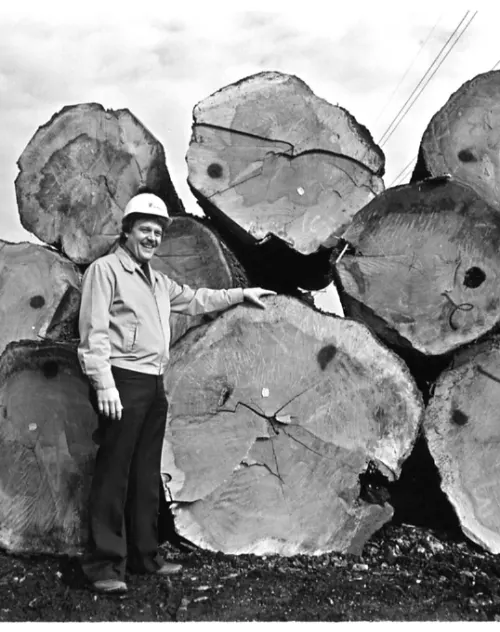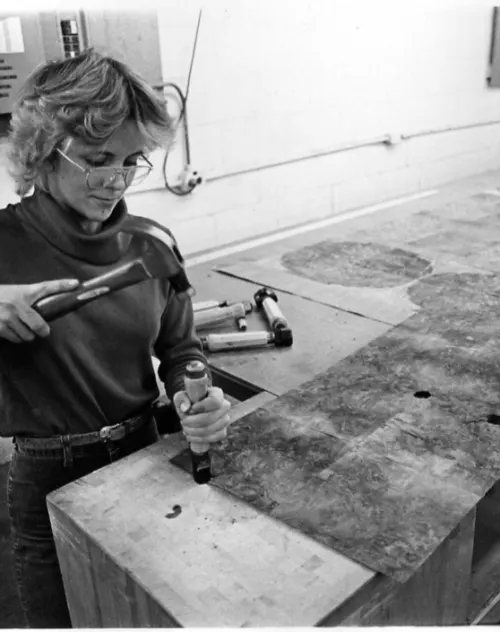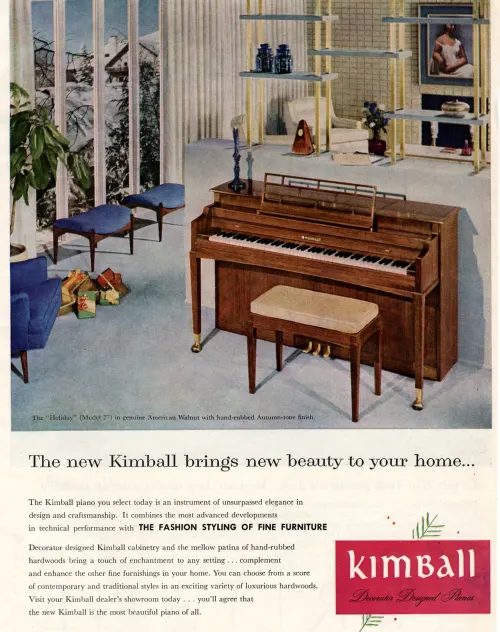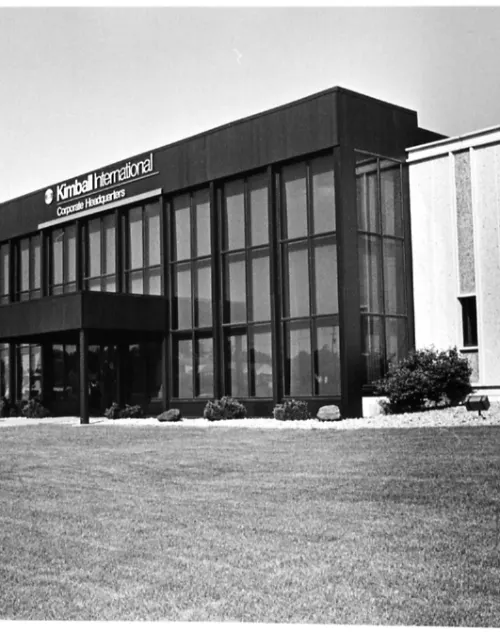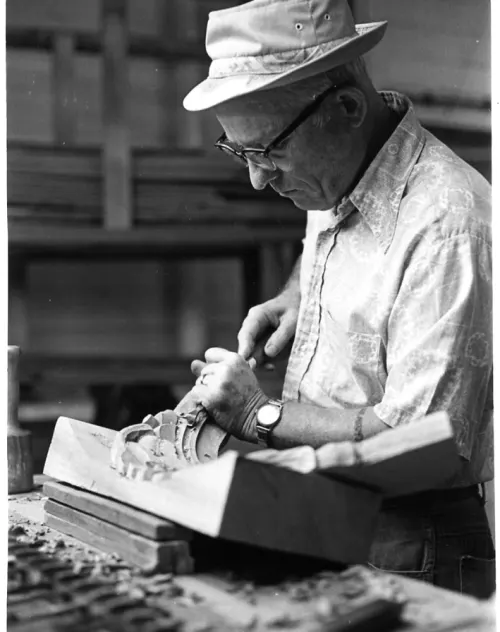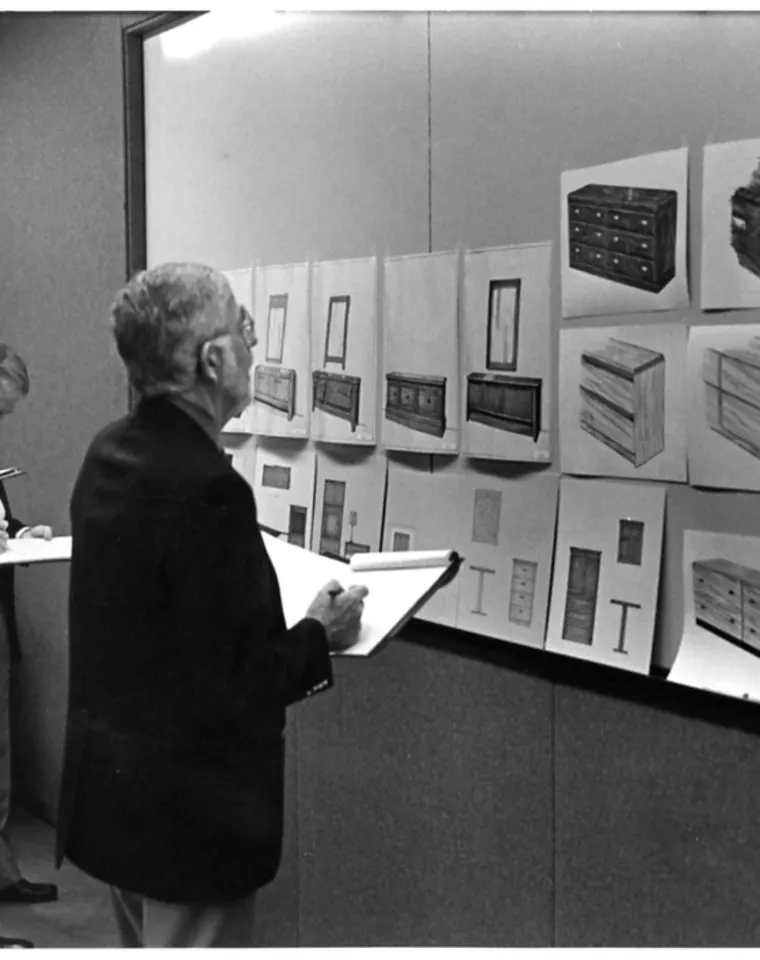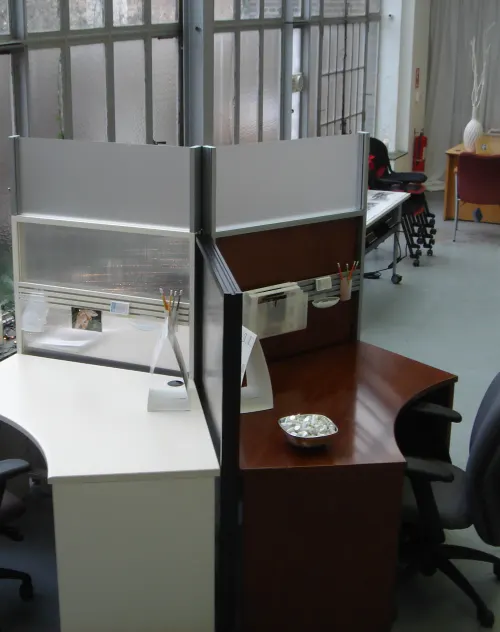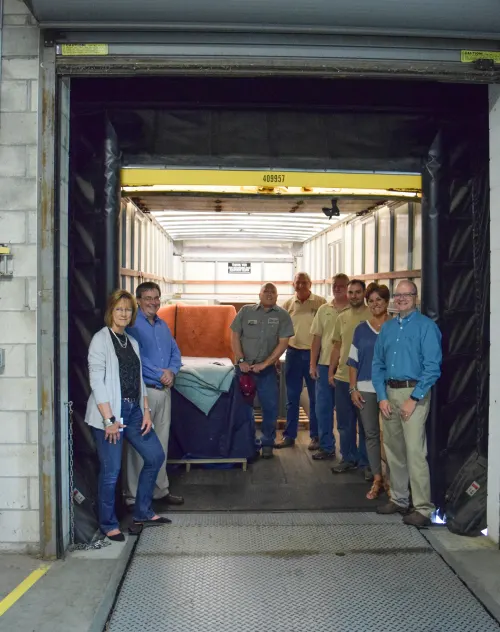Throughout the 1950s, a number of steps were taken to strengthen a system of vertical integration, a key factor in the company's long-term success. Vertical integration meant the company was largely self-sufficient in every aspect of wood manufacturing, from raw materials to production to marketing and distribution.
However, with an eye to growing the company, Mr. Habig began looking for a product or company to acquire which could provide more production stability, increase diversity and create even more growth potential. To best utilize employees' skills, it was felt the end product must be made primarily of wood.
A System of Vertical Integration
Mr. Arnold F. Habig led a small group of investors in the purchase of a struggling Jasper, Indiana company known as Midwest Manufacturing with sales in 1949 of a mere $152,163.
In 1950, the company was reorganized and renamed The Jasper Corporation. The company was a contract manufacturer of residential furniture and television cabinets. The Jasper Corporation ended the year 1950 with sales of $748,000 and the promising potential for even stronger growth.
The Jasper Corporation
Anticipating the growth of a great new phenomenon called television, the company's founders led the young operation into the manufacturing of plywood and high-quality veneered television cabinets and hi-fi stereo phonograph cabinets. The new company was soon making products for a number of well-known American brands.
Television Phenomenon
In 1952, the company made its first acquisition, a kitchen cabinet manufacturer, and began a process of self-funded growth and strategically adding and expanding production capabilities to broaden its scope.
The First Acquisition
In 1959, the W.W. Kimball Company, a century-old piano maker, was purchased from the last remaining Kimball family heir by Mr. Arnold F. Habig, becoming a wholly-owned subsidiary of The Jasper Corporation.
William Wallace Kimball had founded the W.W. Kimball Piano Company in 1857 in Chicago. The original W.W. Kimball piano factory was located at 26th and California Streets in Chicago. Destroyed by fire with the loss of many historical records, a new factory was later built in Melrose Park, Illinois. The W.W. Kimball piano factory was one of the largest manufacturing operations in the world, with rail lines running through the facility, dropping off raw materials and picking up finished pianos for shipment.
W.W. Kimball was the world's largest piano manufacturer from the late 1800s until the Great Depression of the 1930s. Despite pursuing War Department contracts to manufacture needed items for the war effort during World War II, the company was never able to fully recover.
Prior to Mr. Habig purchasing the W.W. Kimball in 1959, the piano company had slipped to seventh place in global rankings of piano makers. At the time it was purchased, the W.W. Kimball Company was producing only 15-25 pianos per day in Melrose Park, Illinois.
Our First Consumer Product
During the 1960s and 1970s, the company was manufacturing approximately 100,000 pianos and organs per year, remaining true to the piano company's original sales slogan, "Music For The Millions." Kimball Piano and Organ produced 250 pianos and 150 electronic organs per day.
This success further fueled the growth of The Jasper Corporation into other markets. Based on the quality reputation associated with the Kimball name, the company was poised to develop other product lines.
Music for the Millions.
In 1961, in conjunction with the relocation of Kimball piano production from Illinois to Indiana, the company formed Jasper Electronics Manufacturing Company to develop and produce Kimball organs for the home entertainment market.
Piano production was relocated to the small, southern Indiana town of West Baden, Indiana, where the company was rejuvenated and once again began to grow, now operating under the Kimball Piano and Organ name. Ten years after the purchase, Kimball was once again the world's largest piano brand.
Jasper Electronics
In 1970, the company decided to manufacture and market office furniture under the Kimball brand name. This strategic decision profoundly affected the company's future. Upon its introduction, the Kimball office furniture brand quickly achieved success in the marketplace, building a reputation for fine craftsmanship, high-quality products and quick delivery. Kimball implemented the market's first incentive trip program, patterned after the extremely successful dealer program in use for many years by Kimball Piano and Organ.
Building a Reputation.
In July 1974, The Jasper Corporation changed its name to Kimball International, in part because of the strength and reputation of the Kimball brand name. The company made its initial public offering (IPO) of 500,000 shares of common stock in September 1976, becoming a publicly-held company and trading on the NASDAQ Exchange under the ticker symbol KBALB.
Kimball International
Just as the company rode the wave of the television revolution in the 1950s, Kimball International took advantage of a prime opportunity to develop a whole new set of customer relationships in the electronics technology revolution of the 1980s. Already firmly established in the market, the company diversified its contract electronics business. As electronic organ production phased out, the company took advantage of many of the processes already in place from organ production and created Kimball Electronics.
Electronics Technology.
In 1980, Kimball International again expanded its influence in the office furniture market. National Office Furniture was formed to service the large mid-market segment. In 1985, the Kimball brand introduced workplace systems to address the growing open-plan office furniture design standards.
Expanding Influence
Kimball International entered the hospitality market in 1985, quickly becoming a premier supplier. A significant strength of Kimball Hospitality is the speedy and reliable ability to engineer and mass produce custom-designed and specialty furnishings. Kimball Hospitality's reputation as a leading furnishings supplier has resulted in customers choosing its brand productions for over 60,000 guest rooms for hotel chains, luxury properties and resort destinations worldwide.
The Hospitality Market.
As society changed and other means of electronic entertainment came on the scene, the market for pianos and organs began to shrink. Many piano companies went bankrupt. The global market for pianos shrank to a number less than what the company alone produced in a single year. In February 1996, the Board of Directors of Kimball International approved a resolution to cease piano manufacturing operations and align those resources into the company's contract furniture and cabinets group.
The last Kimball grand piano to be produced was autographed by every piano worker, as well as every executive, and remains on display in the Kimball International Headquarters in Jasper, Indiana.
Because of their quality construction and craftsmanship, many fine Kimball pianos and organs are still in use in homes and schools. They are found on the used instrument and collector markets.
Electronic Entertainment.
The challenges of global competition, changing markets and a softened economy in the early 2000s were met head on by Kimball International, as the company adapted and kept moving forward.
A company-wide restructuring and business consolidation was announced in 2001 to reduce excess capacity in manufacturing operations and improve performance results. The company exited the metal stamping, polyurethane plastics, contract store fixtures and dimension wood products portions of its business.
Moving Forward.
While remaining clearly focused on its strategic vision, Kimball International announced and executed a careful plan to exit non-core markets and to divest several unprofitable business operations. The company ceased marketing of its Kimball branded residential furniture.
Strategic Vision.
Adaptability has been a hallmark of Kimball International. It has also been a proven competitive advantage.
Historically, the company's furniture segment had operated in a decentralized organizational model that supported many diversified businesses in a variety of markets. In 2005, the company announced a business model change. The company realigned its furniture segment manufacturing and marketing into one streamlined and integrated organization, focused on serving customers in only the office furniture and hospitality markets. The new model focused on simplification and standardization of business processes, improving management alignment and reducing cost structures in support of a strategy to enable segment growth.
Adaptability. A Proven Advantage.
The company had clearly sharpened its focus on two market segments: commercial office furniture and contract electronics. After 56 years of continuous production, the company manufactured its last TV cabinet. This event brought the end of an era in the company's history by effectively ending the company's involvement in contract manufacturing.
In its Electronic Manufacturing Services segment, the company further expanded its global footprint of operations in Europe and Asia to service its worldwide customers. While retaining its reputation as a leader in automotive electronics, Kimball Electronics actively diversified its business in the medical, automotive, industrial, and public safety market sectors.
Sharpened Focus.
On November 1, 2014, Kimball International spun-off its Kimball Electronics business segment to an independent publicly-traded company. Kimball International transformed again into a focused furniture company and continued as a publicly-traded company on the NASDAQ Exchange under the ticker symbol KBAL.
Kimball International now creates design driven, innovative furnishings sold through the family of brands: Kimball Office, National Office Furniture, and Kimball Hospitality. The diverse portfolio offers solutions for the workplace, learning, healing, and hospitality environments. Dedicated to the company's Guiding Principles, its values and integrity are evidenced by public recognition as a highly trusted company and an employer of choice.
Focused Furniture Company.
Since 2014, Kimball International has focused on the profitable growth of its three brands, Kimball, National, and Kimball Hospitality. 2017 saw our Kimball and National brands get recognized for numerous awards in the contact and education markets. Our hospitality brand achieved record sales in fiscal 2017 of products going into the most recognized hotels in the US and worldwide. Additionally, Kimball International was recognized as A Great Place to Work® for the third consecutive year.
Building Success. Delivering Results.
With a set of targeted acquisitions, Kimball International welcomes D’style by Kimball Hospitality, the David Edward Collection by Kimball and Poppin into the company’s family of brands. Launches of Etc., an on-trend workspace brand, and Interwoven, the company’s health brand, further expand the growing portfolio.
This brand expansion is mirrored by the company’s launch of four core business units: Workplace, Health, Hospitality and eBusiness. Under this new structure, Kimball International’s industry specialists apply their long-standing expertise to the company’s cross-brand strategy and vision for future — guiding Kimball International’s transformation into a market-leading omnichannel commercial furnishings powerhouse.

